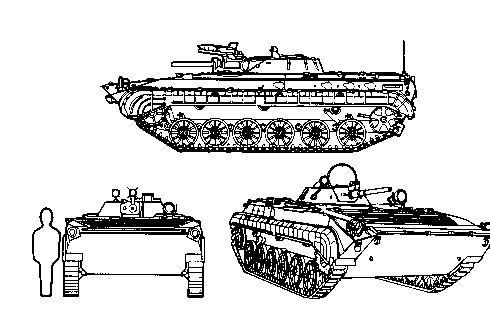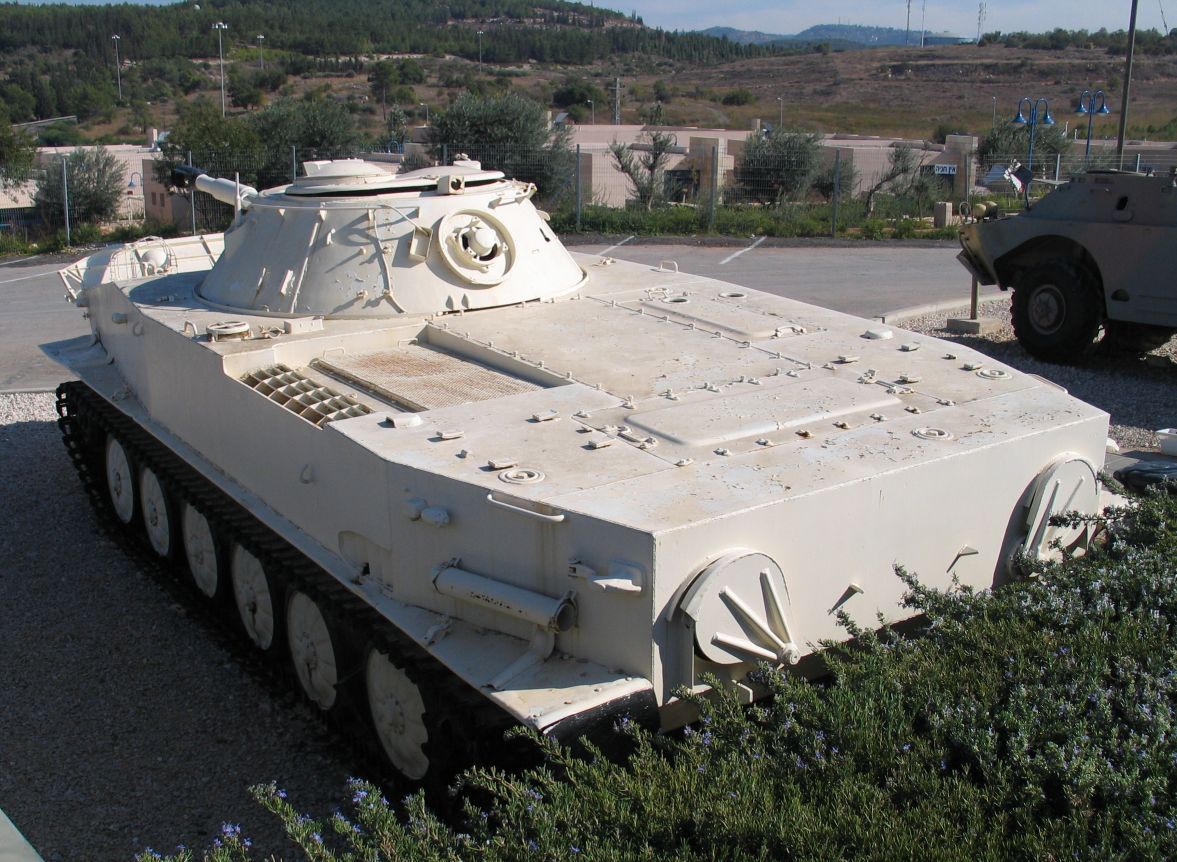|
List Of BMP-1 Variants
This is a complete list of formal variants and designations of the BMP-1 infantry fighting vehicle (IFV). It is sorted by country of origin. Many field modifications may exist that are not listed here. Variants Soviet Union Infantry fighting vehicles * BMP (Ob'yekt 764) – The original main prototype of the BMP-1 was developed by the design bureau of the Chelyabinsk Tractor Works (ChTZ) and built in 1965. In comparison with Ob'yekt 765Sp1, Ob'yekt 764 was 4 mm higher, had a maximum swimming speed of 10 km/h, a lower maximum range (550 km on road) and a reduced number of firing ports for its passenger's armament (six). The vehicle had a curved shock-absorber behind the first road wheel and the rear fender and two tool stowage boxes on the fenders. To start production of the new vehicle, the design of the fighting and troop compartments were improved. Unlike the BMP-1, Ob'yekt 764 used a waterjet for swimming, which was removed to save space inside the vehicle. ... [...More Info...] [...Related Items...] OR: [Wikipedia] [Google] [Baidu] |
BMP-1
The BMP-1 is a Soviet Union, Soviet Amphibious vehicle, amphibious tracked infantry fighting vehicle that has been in service from 1966 to the present. BMP stands for ''Boyevaya Mashina Pyekhoty 1'' (), meaning "infantry fighting vehicle, 1st serial model". The BMP-1 was the first mass-produced infantry fighting vehicle (IFV) of the Soviet Union. It was called the M-1967, BMP and BMP-76PB by NATO before its correct designation was known. The Soviet military leadership saw any future wars as being conducted with nuclear, chemical and biological weapons. A new design, like the BMP, combining the properties of an armoured personnel carrier (APC) and a light tank would allow infantry to operate from the relative safety of its armoured, radiation-shielded interior in contaminated areas and to fight alongside it in uncontaminated areas. It would increase infantry squad mobility, provide fire support to them, and also be able to fight alongside main battle tanks. The BMP-1 was first ... [...More Info...] [...Related Items...] OR: [Wikipedia] [Google] [Baidu] |
Kubinka Tank Museum
The Kubinka Tank Museum (Центральный музей бронетанкового вооружения и техники - Tsentral'nyy Muzey Bronetankovogo Vooruzheniya I Tekhniki -Central Museum of Armored Arms and Technology) is a large military museum in Kubinka, Odintsovsky District, Moscow Oblast, Russia where tanks, armoured fighting vehicles (AFVs) and their relevant information are displayed and showcased. The museum consists of open-air and indoor permanent exhibitions of many famous tanks and armored vehicles from throughout the 20th and 21st centuries (between 1917 and the present day). It also houses and displays many unique, unusual and one-of-a-kind military vehicles of which there are very few remaining examples, such as the German Panzer VIII Maus super-heavy tank, Object 279, Troyanov's Object 279 Kotin heavy tank, the Karl-Gerät heavy self-propelled artillery, and the SU-152 "Taran", Object 120 Su-152 "Taran" tank destroyer, amongst other single or limit ... [...More Info...] [...Related Items...] OR: [Wikipedia] [Google] [Baidu] |
2S1 Gvozdika
The 2S1 ''Gvozdika'' (, "Dianthus caryophyllus, Carnation") is a Soviet Self-propelled artillery, self-propelled howitzer introduced in 1972 and is in service in Russia and other countries . It is based on the MT-LBu multi-purpose chassis, mounting a 122 mm howitzer 2A18 (D-30), 122 mm 2A18 howitzer. "2S1" is its GRAU designation. An alternative Russian designation is SAU-122, but in the Russian Army it is commonly known as ''Gvozdika''. The 2S1 is fully Amphibious vehicle, amphibious with very little preparation, and once afloat is propelled by its tracks. A variety of track widths are available to allow the 2S1 to operate in snow or swamp conditions. It is CBRN defense, NBC protected and has infrared night-vision capability. The 2S1 was developed in Kharkiv, Ukrainian Soviet Socialist Republic. It has seven road wheels on each side; the running gear can be fitted with different widths of track to match terrain. The interior is separated into a driver's compartment on the l ... [...More Info...] [...Related Items...] OR: [Wikipedia] [Google] [Baidu] |
Land Forces (26855856672) , a former British Army command
{{Disambiguation ...
Land Force or Land Forces may refer to: *Land army or army * Albanian Land Force *Azerbaijani Land Forces * Bulgarian Land Forces *Canadian Forces Land Force Command, the former name of the Canadian Army *Czech Land Forces *Estonian Land Forces *Georgian Land Forces *Land Forces of the Democratic Republic of the Congo *Land Forces of the National People's Army, a former army branch in the German Democratic Republic *Latvian Land Forces * Lithuanian Land Force *Multinational Land Force – Italy, with Hungary and Slovenia *Polish Land Forces *Romanian Land Forces * Royal Brunei Land Force *Turkish Land Forces *United Kingdom Land Forces United Kingdom Land Forces was a command of the British Army responsible for generating and preparing forces for current and contingency operations. The commander of the forces was known as Commander-in-Chief, United Kingdom Land Forces, who in ... [...More Info...] [...Related Items...] OR: [Wikipedia] [Google] [Baidu] |
Self-propelled Gun
Self-propelled artillery (also called locomotive artillery) is artillery equipped with its own propulsion system to move toward its firing position. Within the terminology are the self-propelled gun, self-propelled howitzer, self-propelled mortar, and self-propelled rocket artillery. They are high-mobility vehicles, usually based on continuous tracks carrying either a large field gun, howitzer, mortar (weapon), mortar, or some form of rocket (weapon), rocket/missile launcher. They are usually used for long-range indirect-fire, indirect bombardment support on the battlefield. In the past, self-propelled artillery has included direct-fire vehicles, such as assault guns and tank destroyers, which were typically well-armoured vehicles often based upon the chassis of a tank. In lieu of the standard tank's general-purpose tank gun, main gun that fired both high-explosive and anti-tank ammunition, direct-fire vehicles had specialized roles, with assault guns providing close fire-supp ... [...More Info...] [...Related Items...] OR: [Wikipedia] [Google] [Baidu] |
BRDM-2
The BRDM-2 (''Boyevaya Razvedyvatelnaya Dozornaya Mashina'', Боевая Разведывательная Дозорная Машина, literally "Combat Reconnaissance/Patrol Vehicle") is an amphibious armoured scout car designed and developed in the Soviet Union. It was also known under the designations BTR-40PB, BTR-40P-2 and GAZ 41-08. This vehicle, like many other Soviet designs, has been exported extensively and is in use in at least 38 countries. It was intended to replace the older BRDM-1, and has improved Amphibious vehicle#Armoured, amphibious capabilities and better armament compared to its predecessor. History After a few years of use by the Soviet Army, the limitations and drawbacks of the BRDM-1 became obvious. The vehicle had no turret and to operate the armament the gunner had to open a hatch and expose himself to enemy fire. The vehicle was not fitted with an NBC protection system, and had no night vision equipment by default. The vehicle also lacked any kind o ... [...More Info...] [...Related Items...] OR: [Wikipedia] [Google] [Baidu] |
PT-76
The PT-76 is a Soviet Union, Soviet amphibious vehicle, amphibious light tank that was introduced in the early 1950s and soon became the standard reconnaissance tank of the Soviet Army and the other Warsaw Pact armed forces. It was widely exported to other friendly states, like India, Indonesia, Iraq, Syria, North Korea and North Vietnam. The tank's full name is Floating Tank–76 (, ''plavayushchiy tank'', or , ''PT-76''). ''76'' stands for the caliber of the main armament: the 76.2 mm D-56T series rifled tank gun. The PT-76 is used in the reconnaissance and fire-support roles. Its chassis served as the basis for a number of other vehicle designs, many of them amphibious, including the BTR-50 armored personnel carrier, the ZSU-23-4 self-propelled anti aircraft gun, the ASU-85 airborne self-propelled gun and the 2K12 Kub anti-aircraft missile launch vehicle. Development After World War II, the concept of light tanks was resurrected in the USSR. They were to be used in recon ... [...More Info...] [...Related Items...] OR: [Wikipedia] [Google] [Baidu] |
TB2015ExhibitionP2-33
TB or Tb may refer to: Science and technology Computing * Terabyte (TB), a unit of information (often measuring storage capacity) * Terabit (Tb), a unit of information (often measuring data transfer) * Thunderbolt (interface) * Test bench Vehicles * T.B. (Thompson Brothers), a three-wheeled cyclecar manufactured by Thompson Brothers of Bilston, England, from 1919 until 1924 * Torpedo boat, a relatively small and fast naval vessel designed to carry torpedoes into battle * A US Navy hull classification symbol: Torpedo boat (TB) Places in the United States * Boeing TB, an American torpedo bomber biplane designed by the US Navy and built by Boeing in 1927 Other uses in science and technology * Terbium, symbol Tb, a chemical element * Terrific broth, a bacterial growth medium for ''E. coli'' * Tuberculosis (TB), a chronic infectious disease ** ''Tubercle bacillus'', another name for ''Mycobacterium tuberculosis'', the pathogen causing tuberculosis. * Brightness temperature (Tb), in ... [...More Info...] [...Related Items...] OR: [Wikipedia] [Google] [Baidu] |
R-123
R-123 "Magnolia" (Р-123 «Магнолия») is a Soviet military HF/ VHF radio transceiver designed for use in tanks and other armoured vehicles. The device was made in the Ryazan radio plant. Deployment The R-123 set was commonly used in conjunction with the R-124 intercom system in armoured vehicles. Introduced in the early 1960s, the R-123 set was also adopted by other Warsaw Pact members and exported to countries such as Finland, Egypt, and Iraq. Technical specifications R-123 * FM, superheterodyne high- HF/low- VHF two-way voice tactical tank radio transceiver operating in the 20 MHz to 51.5 MHz range. Circuitry consists of 32 valves and various semiconductor devices. *Tuning system: In addition to manual tuning, up to 4 preset channels can be selected using a motorized servo system. *Frequency range: **Band 1 = 20.00 - 35.75 MHz **Band 2 = 35.75 - 51.50 MHz *Channel spacing: 25 kHz *1,260 total available channels *Transmitter power: 20 W *Range: 20 ... [...More Info...] [...Related Items...] OR: [Wikipedia] [Google] [Baidu] |




